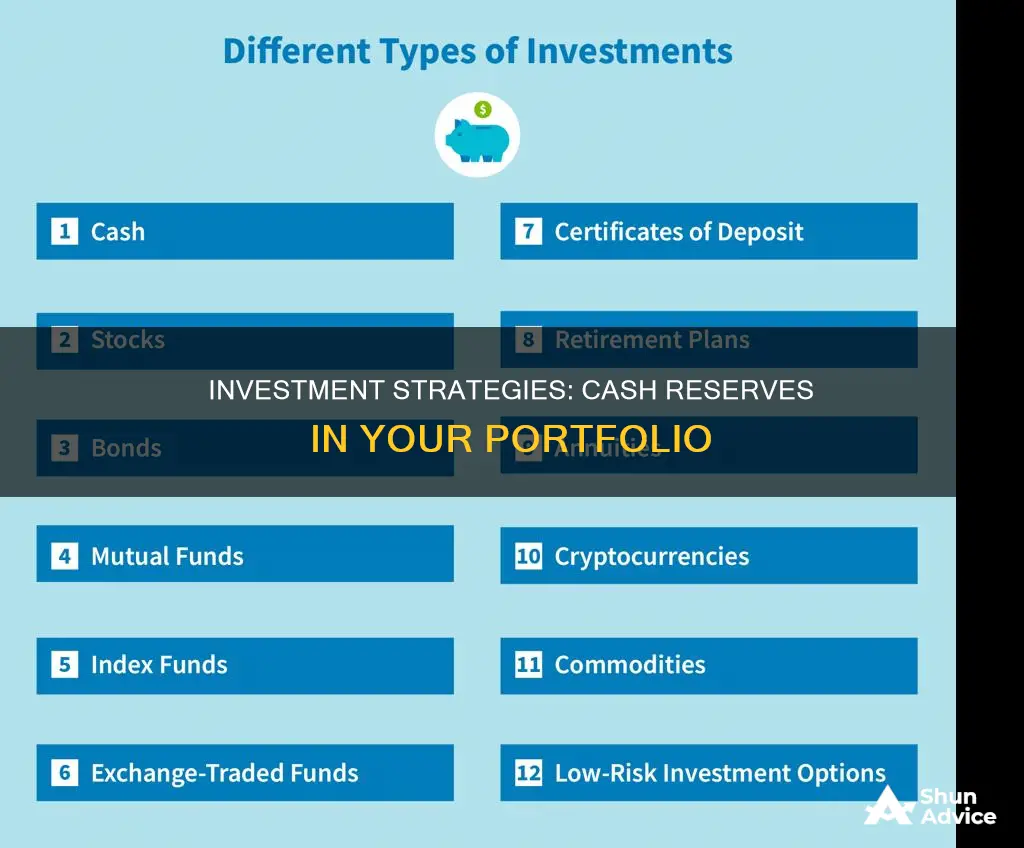
Deciding whether to keep all your cash in an investment portfolio depends on several factors, including your financial goals, time horizon, risk tolerance, and funding level. While some investors view cash as a wasted asset that earns lower interest compared to other investments, others believe that keeping cash on hand provides opportunities and flexibility.
Determining the ideal amount of cash to hold in a portfolio requires a personalized approach. Most financial experts recommend having at least three to six months' worth of living expenses set aside as an emergency fund. Additionally, investors should consider their age, with younger investors typically advised to hold less cash due to their longer investment horizon.
Cash offers safety and liquidity, especially during volatile market conditions, but it may not be ideal for long-term investment goals due to its low long-term returns and vulnerability to inflation. Therefore, investors must carefully weigh the potential risks and rewards when deciding how much cash to keep in their investment portfolio.
| Characteristics | Values |
|---|---|
| Pros | Stability, risk and return, accessibility |
| Cons | Lower long-term returns, shortfall risk, inflation uncertainty |
| Cash investments | Money in your bank account or wallet, short-term investments that are FDIC-insured and offer interest payment |
| Cash reserves | Emergency fund, living expenses for at least 3-6 months, savings for unexpected expenses |
| Cash allocation | Depends on your goals, time horizon, risk tolerance, funding level, age, career goals, and investment strategy |
| Cash as a distinct asset class | Safety, liquidity, stable principal amounts, higher yields |

Liquidity and safety
Liquidity
Liquidity is a critical factor in investment portfolio management. It refers to the ease with which assets can be converted into cash without incurring significant losses. Maintaining adequate liquidity enables individuals and institutions to meet their short-term financial obligations and handle unexpected cash flow demands.
A lack of liquidity can be extremely dangerous for companies, even those in good health. It is crucial to know the appropriate liquidity level required to maximise yield and minimise risk.
Having too much cash in a portfolio can result in missed opportunities for higher returns, while insufficient liquidity can lead to the premature sale of investments, potentially causing market risk. Therefore, it is essential to strike a balance.
Safety
Safety is another vital aspect of investment portfolio management. It involves preserving and safeguarding capital while earning desirable market rates. Safety measures aim to protect against losses and ensure the continuity of operations.
One safety measure is maintaining emergency funds or cash reserves to cover unexpected expenses or financial duress. For individuals, this typically means having enough cash to cover living expenses for several months.
Additionally, diversifying investment portfolios can enhance safety by reducing risk. This involves spreading investments across various assets, maturities, and funding sources to protect against market fluctuations and interest rate changes.
In summary, when considering whether to keep all your cash in an investment portfolio, it is essential to weigh the benefits of liquidity and safety against the potential opportunity cost of missing out on higher returns by keeping cash idle.
Investing vs. Saving: Brainly's Guide to Financial Strategies
You may want to see also

Emergency funds
When it comes to emergency funds, accessibility and liquidity are crucial. You want to ensure that you can easily access your money in case of an emergency, without incurring penalties or sacrificing liquidity. Therefore, it is generally advised to keep your emergency funds in highly liquid assets, such as a savings account, checking account, money market account, or high-yield savings account. These accounts offer easy access to your funds and typically do not have withdrawal penalties.
While it may be tempting to invest your emergency funds to earn higher returns, it is important to remember that investments such as stocks, real estate, or even low-risk investments like certificates of deposit (CDs) come with their own set of risks. If you invest your emergency funds and need to withdraw them quickly, you may be forced to sell at a loss or incur early withdrawal fees.
Additionally, by keeping your emergency funds separate from your long-term investments, you can avoid the temptation to dip into your investments prematurely, potentially selling at a loss. This separation also allows your investments to continue working towards your financial goals uninterrupted.
In summary, when considering emergency funds, focus on accessibility and liquidity. Keep your emergency funds in highly liquid assets that are easily accessible and avoid investing them in volatile assets that may compromise your ability to withdraw funds quickly and safely.
Sharing Investment Strategies: Splitting Portfolios with Family
You may want to see also

Long-term goals
When it comes to long-term goals, it is generally not advisable to keep all your cash in an investment portfolio. While cash is a safe and liquid asset, it typically generates lower returns compared to other investments, such as stocks or bonds.
Time Horizon and Risk Tolerance
The time horizon, or the length of time you plan to hold your investments, is an important factor. If you are many years away from retirement, you may not need to allocate a large portion of your portfolio to cash, assuming you have an emergency fund and sufficient liquid assets to cover short-term needs.
Your risk tolerance, or the degree of variability in investment returns you are willing to accept, is another crucial factor. If you have a high-risk tolerance, you may be more comfortable with a smaller allocation to cash and a larger allocation to higher-risk, higher-return assets such as stocks.
Inflation Risk
Cash has historically struggled to keep up with inflation, which means the purchasing power of your money may decrease over time. This can impact your ability to meet your long-term financial goals.
Opportunity Cost
By keeping a large portion of your portfolio in cash, you may miss out on the potentially higher returns offered by other investments. Stocks and bonds, for example, have historically delivered average annual returns that have exceeded the rate of inflation.
Diversification
For long-term investment goals, it is generally recommended to diversify your portfolio across various asset classes, including stocks, bonds, and other investments. This helps maximize your potential for growth and minimizes the risk of having all your eggs in one basket.
Emergency Funds and Short-Term Needs
While it is generally advised to keep a portion of your portfolio in cash, this does not necessarily mean keeping all of it in your investment portfolio. It is important to maintain an emergency fund containing at least three to six months' worth of living expenses in a highly liquid form, such as a savings account. This ensures that you have easy access to funds in case of unexpected expenses or financial shocks.
Age and Life Stage
Your age and life stage play a crucial role in determining your investment strategy. If you are a younger investor, you may not need to hold as much cash since you have a longer time horizon to weather market corrections and take advantage of long-term growth opportunities. As you get closer to retirement, it becomes more important to have a larger portion of your portfolio in cash or other low-risk assets to provide a stable source of income.
In summary, while keeping some cash in your investment portfolio is essential for liquidity and risk management, it is generally not advisable to keep all your cash invested in the long term. Diversification, emergency funds, and considering your age and risk tolerance are key aspects of a well-balanced long-term investment strategy.
Saving and Investing: Building Wealth and Security
You may want to see also

Risk and return
When considering whether to keep all your cash in an investment portfolio, it is essential to understand the risk-return relationship. This relationship suggests that the higher the potential return of an investment, the higher the risk. In other words, increased potential returns usually go hand-in-hand with increased risk.
Diversification is a strategy that enables investors to reduce the overall risk associated with their portfolio without sacrificing potential returns. By spreading investments across various asset classes, sectors, or investments, the impact of any single risk is minimised. For example, investment managers often mix bonds and stocks in a portfolio, as bond prices tend to rise when stocks experience steep declines.
However, diversification may limit potential returns. Investing solely in one market sector, for instance, may generate superior returns if that sector outperforms the overall market. Nevertheless, if that sector declines, investors may experience lower returns than they could have achieved with a diversified portfolio.
While keeping cash in a portfolio may provide stability and liquidity, it is important to consider the opportunity cost. Cash investments tend to yield lower returns over the long term compared to stocks or bonds, and they may not keep up with inflation.
Therefore, the decision to keep all your cash in an investment portfolio depends on several factors, including your goals, time horizon, risk tolerance, and funding level. For example, an investor with a high-risk tolerance and a long time horizon may opt to exclude cash from their portfolio, while another investor with lower risk tolerance and short-term goals may include cash as a stable component.
Ultimately, the ideal amount of cash to hold in an investment portfolio is a personalised decision that requires careful consideration of these factors to maintain the right balance between liquidity, risk, and return.
Savings and Investment: National Strategies for Economic Growth
You may want to see also

Inflation
The impact of inflation on investment portfolios is significant. Inflation can eat away at your investment returns and erode the value of your savings over time. This is because inflation reduces the purchasing power of money, and when the inflation rate exceeds the interest earned on savings or investments, investors lose money.
For example, if you have $100 in a savings account earning 1% annual interest, you will have $101 at the end of the year. However, if the inflation rate is 2%, you would need $102 to maintain your purchasing power, thus resulting in a loss.
The impact of inflation on different types of investments varies:
- Cash and cash equivalents: These investments are vulnerable to inflation risk. When there is no interest being generated or when the interest earned does not keep up with the inflation rate, inflation can quickly erode the purchasing power of cash holdings.
- Fixed-income investments: Inflation can significantly reduce real returns on fixed-income investments such as corporate or municipal bonds, treasuries, and certificates of deposit (CDs). As inflation rises, the purchasing power of the interest payments declines, and bond prices tend to fall.
- Stocks: In theory, stock prices should rise along with the general increase in consumer and producer goods prices. However, high inflation can negatively affect nominal returns. Value stocks tend to perform better than growth stocks during high inflation.
- Real assets: Commodities, real estate, and precious metals tend to have a positive relationship with inflation. As the prices of goods and services containing commodities increase, the prices of commodities themselves also tend to rise. Similarly, property owners often increase rent payments in line with inflation, which can flow through to higher profits and investor distributions.
To safeguard savings and investment portfolios against inflation, investors can consider the following strategies:
- Money market or high-yield savings accounts: Choosing accounts that earn a return higher than the inflation rate can help maintain the purchasing power of savings.
- Treasury Inflation-Protected Securities (TIPS): TIPS adjust the interest payouts and principal payments based on changes in the Consumer Price Index (CPI), thus providing protection against inflation.
- Government bonds: Longer-term government bonds offer reliable income with lower reinvestment risk and generally higher returns than cash or short-term bonds over the long term.
- Precious metals: Investing in gold, silver, or other precious metals, either directly or through exchange-traded funds (ETFs), is a traditional strategy to outpace inflation.
- Inflation-indexed bonds: These bonds offer a variable interest rate tied to the inflation rate, helping to maintain the purchasing power of the investment. Examples include Treasury Inflation-Protected Securities (TIPS) in the United States and similar options in other countries.
- Consumer staples stocks: Investing in companies that can pass their rising input costs to customers, such as those in the consumer staples sector, may help keep pace with inflation.
It is important to note that the decision to keep cash in an investment portfolio depends on various factors, including personal financial circumstances, goals, time horizon, and risk tolerance. While cash reserves can provide stability and liquidity, they may also result in lower long-term returns and the potential for shortfall risk, especially during periods of high inflation. Therefore, it is crucial to carefully consider the benefits and drawbacks of holding cash in an investment portfolio and to seek advice from financial professionals when making investment decisions.
Rebalancing Your Investment Portfolio: A Guide to Getting Started
You may want to see also
Frequently asked questions
Keeping cash in your investment portfolio can provide a wealth of opportunities. It allows you to be agile and take advantage of financial opportunities that arise, such as buying stocks at low prices. Cash also offers immediate liquidity, which can be advantageous during emergencies or market downturns. Additionally, cash is a safe and stable asset, providing peace of mind and minimising losses in your portfolio.
Keeping all your cash in your investment portfolio can result in lower long-term returns compared to investing in stocks or bonds. Cash may not be able to keep up with inflation, leading to a potential loss in purchasing power over time. Additionally, keeping all your cash in your portfolio means missing out on market gains and the potential for higher returns associated with other investments.
The ideal amount of cash to keep in your investment portfolio depends on various factors, including your financial goals, time horizon, risk tolerance, funding level, and life stage. It is recommended to have at least three to six months' worth of living expenses set aside as an emergency fund. For retirees, financial advisors typically suggest keeping at least one to two years' worth of expenses in cash or other low-risk assets. The rest of your portfolio can be invested in stocks, bonds, or other assets depending on your personal circumstances and preferences.







